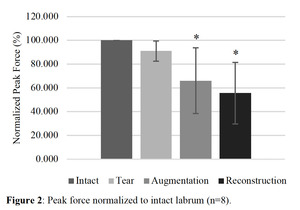INTRODUCTION: An integral component of hip stability is the negative pressure gradient created by the labral suction seal. No prior studies have quantitatively compared the integrity of the suction seal under normal, pathologic, and surgical conditions. The purpose of this study was to evaluate the biomechanical properties of the labral suction seal in the following four scenarios: intact labrum, labral tear, labral augmentation, and labral reconstruction.
METHODS: Eight fresh-frozen hemi-pelvises without osteoarthritis and with an intact labrum were dissected to the level of labrum and mounted for biomechanical testing. Each specimen was evaluated sequentially under four testing conditions: intact labrum, labral tear, labral augmentation, and labral reconstruction. Following testing of the intact labrum, the specimens were manipulated to create a labral tear from 12- to 3-o’clock. Labral augmentation was then performed with bone anchors and iliotibial band graft after debridement of only the peripheral half of the labral tear. Labral reconstruction was performed last with bone anchors and iliotibial band graft after removing the entire labral tear. In each condition the specimens were placed in the test machine to undergo pure distraction of the joint. First, the femur was compressed with 250 N of force and then distracted at 10 mm/s with force and displacement continuously recorded until the suction seal was disrupted. In each specimen, the tests were repeated for a total of three tests in each of the four conditions, and the average peak force was calculated. Data was normalized to the intact peak force for each specimen to account for gender and size differences. Statistical testing was performed via a repeated measures ANOVA with a post hoc Bonferroni correction for pairwise analysis.
RESULTS: Peak loads occurred early in displacement as seen in the representative specimen in Figure 1. The average peak force values (mean N ± standard deviation) were as follows: intact (137.2 ± 40.7), labral tear (126.3 ± 43.5), labral augmentation (94.7 ± 59.7), labral reconstruction (78.9 ± 51.2). Figure 2 shows the average normalized peak force values (mean percent ± standard deviation) relative to the intact condition for the labral tear (91.1 ± 8.5), augmentation (66.1 ± 27.6), and reconstruction (55.6 ± 25.7). There was no statistically significant difference in peak force relative to the intact labrum for the labral tear (p = 0.3392). Relative to the labral tear, there was no significant difference in peak force for the augmentation (p = 0.12), but there was a significant decrease in peak force for the reconstruction (p = 0.03).
CONCLUSION: This model provides a new means of quantitatively evaluating the labral suction seal under various normal, pathologic, and surgical conditions. The results show that relative to the labral tear condition, labral augmentation may recreate the labral suction seal better than labral reconstruction. Clinically, these findings suggest augmentation may improve hip stability over labral reconstruction. Clinical limitations of this study include the small sample size and the biomechanical nature of this study, which does not account for evaluation of an in vivo state following biologic healing.




